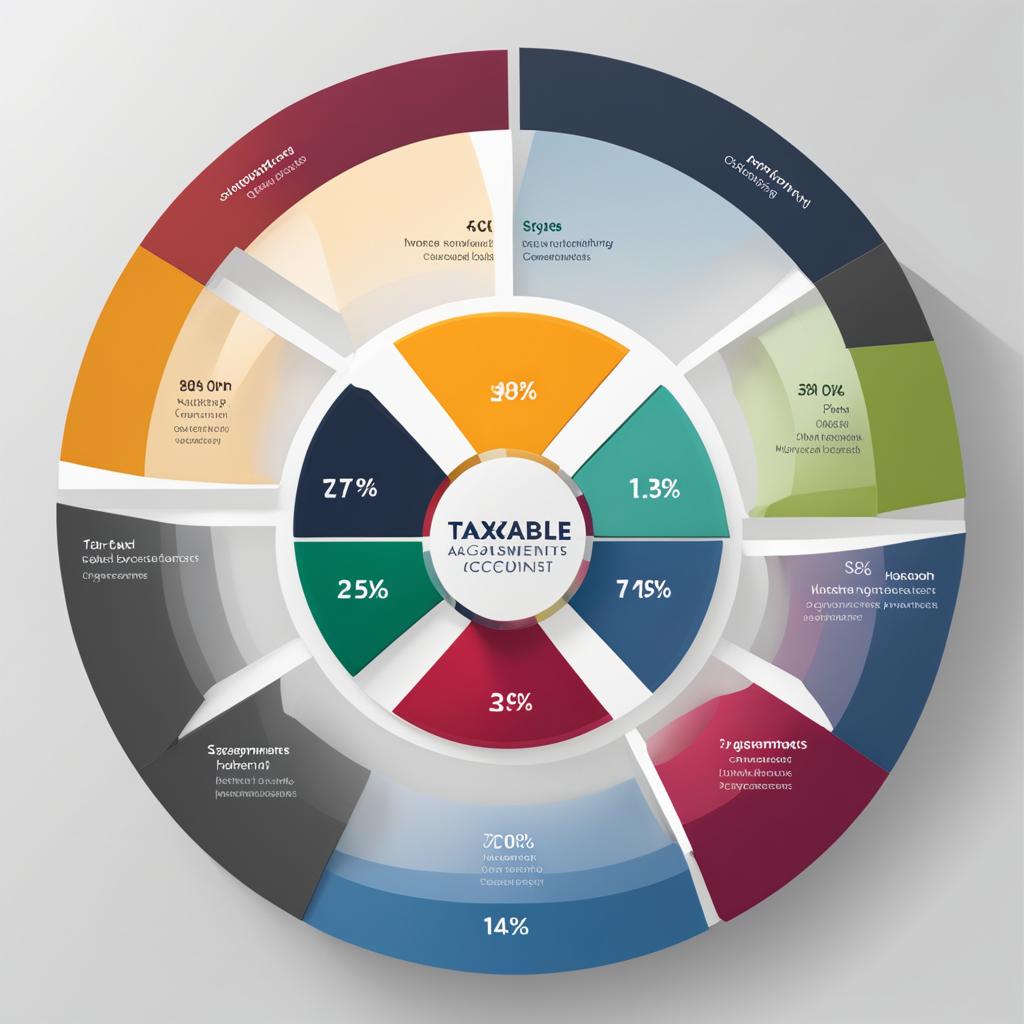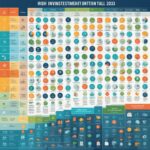As an investor, I understand the importance of making smart financial decisions, especially when it comes to minimizing taxes on my taxable accounts. Fortunately, there are several tax-efficient investment options that can help maximize my after-tax returns while minimizing tax liability. By implementing these strategies, I can ensure that my hard-earned money is working for me in the most efficient way possible.
Key Takeaways:
- Prioritize long-term capital gains to benefit from lower tax rates.
- Consider a buy-and-hold strategy to minimize taxes on frequent trading.
- Choose passive funds like index funds and ETFs for their tax efficiency.
- Earn qualified dividends to take advantage of lower tax rates.
- Select tax-efficient bonds such as municipal bonds and Treasury bonds.
Why Tax-Efficient Investing is Important
Tax-efficient investing plays a vital role in maximizing returns and minimizing taxes for investors. Taxes can have a significant impact on investment returns, and by minimizing the amount of taxes paid, investors can keep more of their hard-earned money and optimize their after-tax returns. This becomes especially crucial for investors in higher tax brackets. To ensure tax efficiency, it is essential to choose the right investments and accounts, such as taxable accounts and tax-advantaged accounts, and employ strategies that minimize tax liability while maximizing after-tax returns.
Investors often overlook the impact of taxes on their investment portfolios. However, even a small reduction in taxes can result in substantial savings and significantly enhance long-term wealth accumulation. By adopting tax-efficient investing principles, investors can effectively manage their tax liability, ultimately leading to improved financial outcomes.
When it comes to tax-efficient investing, one of the primary objectives is to maximize after-tax returns. This involves carefully considering various factors such as investment selection, account selection, and effective tax planning strategies. By optimizing these elements, investors can derive the greatest benefit from their investments.
Choosing the right investments and accounts is an essential aspect of tax-efficient investing. By selecting tax-efficient investments, such as index funds and ETFs, investors can minimize capital gains distributions and reduce their tax liability. Concurrently, utilizing tax-advantaged accounts, such as IRAs and 401(k)s, can provide valuable tax benefits, effectively reducing the tax burden on investment income.
The Benefits of Tax-Efficient Investing
1. Maximizing After-Tax Returns: By minimizing taxes and maximizing after-tax returns, investors can boost their overall portfolio performance and achieve their financial goals faster.
2. Compounding Growth: By minimizing taxes, investors can preserve more of their investment earnings, allowing for greater reinvestment and compounding growth over time.
3. Improved Wealth Accumulation: By diligently managing tax liability, investors can accumulate more wealth over the long term, leading to enhanced financial security and increased opportunities for economic growth.
4. Flexibility and Freedom: Tax-efficient investing affords investors greater flexibility and freedom in managing their investment portfolios, allowing them to make well-informed decisions based on their specific tax situation and financial objectives.
Take Control of Your Taxes with Tax-Efficient Investing
Tax-efficient investing enables investors to be proactive in managing their tax liability and maximizing after-tax returns. By strategically selecting investments, utilizing tax-advantaged accounts, and implementing effective tax planning strategies, investors can benefit from significant savings and improved financial outcomes.
“Investing is not just about generating returns; it’s also about effectively managing your tax obligations to ensure maximum wealth accumulation. With tax-efficient investing, you can take control of your taxes and maximize your after-tax returns.”
Types of Investment Accounts
When it comes to investing, there are two main types of accounts to consider: taxable accounts and tax-advantaged accounts. While both serve their purpose in an investor’s overall strategy, they differ in terms of tax benefits and restrictions.
Taxable Accounts
Taxable accounts, such as brokerage accounts, don’t offer any specific tax benefits. However, they provide investors with more flexibility and freedom when it comes to withdrawals and contributions. With a taxable account, you can access your funds whenever you need them, without any penalties or restrictions. This type of account is ideal for investors who want to maintain control over their investments and have the ability to use the funds outside of retirement or education expenses.
Tax-Advantaged Accounts
On the other hand, tax-advantaged accounts, such as Individual Retirement Accounts (IRAs) and 401(k)s, offer various tax benefits but come with specific restrictions. Contributing to these accounts can result in tax deductions, tax-deferred growth, or even tax-free withdrawals, depending on the type of account. However, there are limits on how much you can contribute annually, as well as rules regarding when and how you can withdraw funds without penalties.
Examples of tax-advantaged accounts include:
- Traditional IRAs
- Roth IRAs
- SEP IRAs
- SIMPLE IRAs
- 401(k)s
- 403(b)s
- 457(b)s
These accounts are particularly advantageous for retirement savings, as they offer tax benefits that can help you grow your wealth more efficiently. However, keep in mind the specific rules and regulations associated with each account when making decisions about contributions and withdrawals.
As an investor, it’s essential to understand the advantages and limitations of both taxable accounts and tax-advantaged accounts. Depending on your financial goals, risk tolerance, and tax planning strategies, you may choose to utilize both types of accounts to optimize your investment portfolio.
Tax-Efficient Investing Strategies
When it comes to investing, minimizing tax liability is a key consideration for investors. By implementing tax-efficient investing strategies, individuals can maximize their after-tax returns and ultimately grow their wealth. Here are some effective strategies to minimize tax liability:
- Prioritize Long-Term Capital Gains: Holding assets for more than a year can lead to lower tax rates on capital gains. By focusing on long-term investments, investors can reduce their tax liability and potentially increase their after-tax returns.
- Embrace a Buy-and-Hold Strategy: Avoiding frequent buying and selling of assets can be advantageous from a tax perspective. A buy-and-hold strategy minimizes the triggering of capital gains taxes and potentially reduces overall tax liability.
- Choose Passive Funds: Passive funds, such as index funds and ETFs, can be tax-efficient investment options. They have lower turnover and fewer capital gains distributions compared to actively managed funds, resulting in reduced tax liability.
- Earn Qualified Dividends: Qualified dividends are taxed at a lower rate than ordinary dividends. By focusing on investments that generate qualified dividends, investors can lower their tax liability and increase after-tax returns.
- Consider Tax-Efficient Bonds: Tax-efficient bonds, such as municipal bonds and Treasury bonds, offer tax advantages. Municipal bonds are exempt from federal taxes, and Treasury bonds are exempt from state and local taxes, reducing tax liability.
- Optimize Asset Allocation for Tax Efficiency: Strategically placing tax-efficient investments in taxable accounts and tax-inefficient investments in tax-advantaged accounts can minimize tax liability and maximize after-tax returns.
- Utilize Charitable Trusts: Donating appreciated securities to a charitable trust can provide tax benefits. Investors can avoid capital gains tax and receive a tax deduction while supporting charitable causes.
- Employ Tax-Loss Harvesting: Selling investments at a loss to offset capital gains can reduce tax liability. However, it’s essential to be aware of the wash-sale rule to avoid violating the associated regulations.
| Investment Strategy | Benefits |
|---|---|
| Prioritize Long-Term Capital Gains | Lower tax rates on capital gains |
| Embrace a Buy-and-Hold Strategy | Minimize capital gains taxes |
| Choose Passive Funds | Reduce capital gains distributions and tax liability |
| Earn Qualified Dividends | Lower tax rates for dividend income |
| Consider Tax-Efficient Bonds | Exempt from certain taxes |
| Optimize Asset Allocation for Tax Efficiency | Maximize after-tax returns |
| Utilize Charitable Trusts | Receive tax benefits, support charitable causes |
| Employ Tax-Loss Harvesting | Reduce tax liability through capital gains offset |
By incorporating these tax-efficient investing strategies, investors can minimize their tax liability and keep more of their hard-earned money. It’s essential to consider these tactics in conjunction with individual financial goals and consult with a financial advisor to tailor the strategies to specific circumstances.
I believe that by implementing tax-efficient investing strategies, individuals can reduce their tax liability and potential increase their after-tax returns, ultimately securing a stronger financial future.
Prioritize Long-Term Capital Gains
When it comes to minimizing tax liability on your investments, prioritizing long-term capital gains can make a significant difference. Unlike short-term capital gains, which are taxed at higher rates, long-term capital gains are subject to lower tax rates.
So how can you take advantage of this tax benefit? By holding onto your investments for at least a year before selling them. This strategy allows you to qualify for long-term capital gains treatment and enjoy the resulting tax savings.
Let’s say you invested in stocks and held them for more than a year. When you decide to sell those stocks, any gains you realize will be classified as long-term capital gains. These gains will be subject to lower tax rates, which means more money stays in your pocket.
By prioritizing long-term capital gains, you can minimize your tax liability and ultimately increase your after-tax returns. It’s a smart strategy for investors looking to optimize their investment outcomes.
\”Prioritizing long-term capital gains is a tax-smart move that savvy investors employ to minimize taxes and boost after-tax returns.\”
Consider a Buy-and-Hold Strategy
A buy-and-hold strategy is a popular approach to investing that involves holding onto investments for an extended period. Rather than constantly buying and selling assets, investors choose to hold onto them, allowing their investments to potentially grow over time. This strategy can have several benefits, including minimizing taxes and maximizing after-tax returns.
One of the key advantages of a buy-and-hold strategy is that it helps investors avoid triggering capital gains taxes through frequent trading. Capital gains taxes are typically incurred when an investment is sold for a profit. By holding onto investments for the long term, investors can delay or avoid paying these taxes altogether, reducing their tax liability.
Additionally, a buy-and-hold strategy can offer potential tax advantages for investors. Long-term capital gains, which are generated when investments are held for more than a year, benefit from lower tax rates compared to short-term capital gains. This favorable tax treatment can result in significant tax savings for investors.
While a buy-and-hold strategy can offer tax benefits, it is important to note that it requires patience and a long-term mindset. Investors must be willing to withstand short-term market fluctuations and remain committed to their investment strategy over time. However, for those who are able to adopt this approach, the potential tax advantages and increased after-tax returns can make it a worthwhile strategy to consider.
By implementing a buy-and-hold strategy, investors can minimize taxes, reduce their tax liability, and potentially increase after-tax returns. It is always recommended to consult with a financial advisor to determine the best investment strategy for individual tax situations.

Choose Passive Funds
When it comes to investing in taxable accounts, choosing the right investment options can help minimize taxes and maximize returns. One strategy investors can employ is to select passive funds, such as index funds and ETFs. These types of funds are designed to track a specific market index, allowing investors to gain exposure to a broad range of assets while keeping costs low.
Passive funds are known for their tax efficiency. Unlike actively managed funds, which frequently buy and sell securities, passive funds have lower turnover rates. This means there are fewer capital gains distributions, resulting in potential tax savings for investors.
Here’s a comparison between passive funds and actively managed funds:
| Fund Type | Turnover Rate | Capital Gains Distributions | Tax Efficiency |
|---|---|---|---|
| Passive Funds (Index Funds and ETFs) | Low | Fewer distributions | High |
| Actively Managed Funds | High | More frequent distributions | Lower |
As seen in the table above, passive funds tend to have higher tax efficiency due to their lower turnover rates and fewer capital gains distributions.
By investing in passive funds, investors can minimize their tax liability and potentially increase after-tax returns. These types of funds are well-suited for taxable accounts, as their tax-efficient nature aligns with the goal of maximizing investment gains while minimizing taxes.
Passive funds provide investors with a simple and effective way to build and maintain a diversified investment portfolio. They offer broad market exposure, low costs, and potential tax advantages that can contribute to long-term financial success.
Earn Qualified Dividends
When it comes to minimizing your tax liability and maximizing after-tax returns, one strategy you can consider is focusing on investments that pay qualified dividends.
Qualified dividends are dividends that meet specific criteria set by the IRS. They are taxed at the same rate as long-term capital gains, which is typically lower than the ordinary income tax rate.
By investing in companies that offer qualified dividends, you can take advantage of these lower tax rates and potentially reduce your overall tax burden.
When selecting investments, look for companies that have a history of consistently paying qualified dividends. These companies are often well-established and financially stable, making them attractive options for long-term investors.
Earning qualified dividends not only provides potential tax savings but also allows you to benefit from the overall growth and profitability of the companies you invest in.
Keep in mind that not all dividends are considered qualified. Non-qualified dividends are typically subject to higher tax rates. Before making any investment decisions, consult with a tax professional or financial advisor to ensure you understand the tax implications.
Benefits of Earning Qualified Dividends
Earning qualified dividends can offer several advantages:
- Tax savings: By taking advantage of the lower tax rates applied to qualified dividends, you can reduce your tax liability and potentially increase your after-tax returns.
- Stability and income: Companies that pay qualified dividends often have a history of stable earnings and a commitment to returning value to shareholders. This can provide a steady stream of income, especially for investors seeking regular cash flow.
- Long-term growth potential: By investing in companies that pay qualified dividends, you can participate in the overall growth and success of these businesses. This can lead to potential capital appreciation over time.
Example: Qualified Dividends
“Investing in high-quality companies that offer qualified dividends has been a effective strategy for minimizing my tax liability and maximizing my after-tax returns. By focusing on stable and established companies with a track record of consistently paying qualified dividends, I have been able to benefit from both the income and growth potential of these investments. It’s important to do your research and consult with a financial advisor to identify the best opportunities for earning qualified dividends.”
Overall, earning qualified dividends can be a valuable component of a tax-efficient investment strategy. By investing in companies that offer qualified dividends, you can potentially reduce your tax liability and increase your after-tax returns while participating in the growth and profitability of these businesses.

Choose Tax-Efficient Bonds
When it comes to tax-efficient investing, one option to consider is investing in tax-efficient bonds. These bonds offer tax advantages that can help minimize your tax liability and potentially increase your after-tax returns. Two popular types of tax-efficient bonds are municipal bonds and Treasury bonds.
Municipal Bonds
Municipal bonds are issued by state and local governments to fund various public projects, such as building schools, roads, or hospitals. One of the key benefits of municipal bonds is their tax-exempt status. These bonds are exempt from federal taxes, and depending on where you live, they may also be exempt from state and local taxes.
By investing in municipal bonds, you can earn income that is completely free from federal taxes, and potentially, from state and local taxes as well. This can have a significant impact on your after-tax returns, especially if you are in a higher tax bracket.
Treasury Bonds
Treasury bonds, also known as T-bonds, are issued by the U.S. government to finance its operations and projects. One important advantage of Treasury bonds is that the interest income they generate is exempt from state and local taxes.
By investing in Treasury bonds, you can earn income that is free from state and local taxes, reducing your overall tax liability. This can result in higher after-tax returns compared to other taxable investments.
Choosing tax-efficient bonds, such as municipal bonds and Treasury bonds, is a smart strategy to minimize your tax liability and potentially increase your after-tax returns. These bonds offer tax advantages that can help you grow your investment portfolio while keeping more of your hard-earned money.
| Bond Type | Tax Exempt |
|---|---|
| Municipal Bonds | Exempt from federal taxes and potentially state and local taxes |
| Treasury Bonds | Exempt from state and local taxes |
Choosing tax-efficient bonds can help minimize tax liability and increase after-tax returns.
Optimize Asset Allocation for Tax Efficiency
When it comes to maximizing after-tax returns on investments, optimizing asset allocation for tax efficiency is a key strategy. By strategically placing tax-efficient investments in taxable accounts and tax-inefficient investments in tax-advantaged accounts, investors can minimize their tax liability and increase their overall returns.
One of the main goals of asset allocation is to ensure a diversified investment portfolio that aligns with an investor’s risk tolerance and financial goals. However, tax efficiency should also be taken into consideration when determining the allocation of investments.
By placing tax-efficient investments, such as index funds or ETFs, in taxable accounts, investors can benefit from their lower capital gains distributions, which can minimize their tax liability. On the other hand, tax-inefficient investments, such as actively managed funds or individual stocks that generate higher levels of short-term capital gains, should be held in tax-advantaged accounts like IRAs or 401(k)s, where the tax impact is reduced or deferred.
Holding tax-efficient investments in taxable accounts also allows investors to take advantage of tax-loss harvesting. This strategy involves selling investments that have declined in value to offset capital gains and reduce taxable income. By strategically harvesting tax losses, investors can minimize their tax liability and potentially increase their after-tax returns.
Optimizing Asset Allocation for Tax Efficiency: Example
Let’s consider an example to illustrate the importance of optimizing asset allocation for tax efficiency:
| Investment | Tax-Efficient Account | Tax-Advantaged Account |
|---|---|---|
| Index Fund | 75% | – |
| Actively Managed Fund | – | 60% |
| Individual Stocks | – | 40% |
In this example, an investor has allocated 75% of their portfolio to a tax-efficient index fund, which is held in a taxable account. The remaining 25% is allocated to an actively managed fund and individual stocks, which are held in tax-advantaged accounts.
By placing the tax-efficient index fund in a taxable account, the investor can benefit from its lower capital gains distributions and potentially reduce their tax liability. On the other hand, the tax-inefficient actively managed fund and individual stocks are held in tax-advantaged accounts, where the tax impact is reduced or deferred.
This optimized asset allocation ensures that the investor maximizes their after-tax returns by minimizing their tax liability on their investments.
By optimizing asset allocation for tax efficiency, investors can enhance their overall investment strategy and potentially increase their after-tax returns. It’s important to consider both the tax implications and the overall investment goals when determining the allocation of investments in taxable and tax-advantaged accounts.

Consider a Charitable Trust
A charitable trust is an excellent option for investors looking to benefit both themselves and charitable causes. By establishing a charitable trust and donating appreciated securities, investors can take advantage of tax benefits while supporting organizations close to their hearts.
When you donate appreciated securities to a charitable trust, you can avoid paying capital gains tax on the appreciation. This can be especially advantageous if you hold highly appreciated assets that would result in significant tax liability if sold.
Additionally, by donating to a charitable trust, you become eligible for a tax deduction based on the fair market value of the donated assets. This deduction can help reduce your taxable income, resulting in potential tax savings.
Investing in a charitable trust not only provides you with tax benefits but also allows you to make a positive impact on the community and causes you care about.
By utilizing this strategy, you can effectively reduce your tax liability while contributing to meaningful charitable endeavors. The tax benefits of a charitable trust can potentially increase your after-tax returns and align your investment strategy with your philanthropic goals.
It’s important to consult with a financial advisor or tax professional to ensure that a charitable trust aligns with your overall financial plan and goals. They can provide you with personalized guidance and help you navigate the complexities of establishing and maintaining a charitable trust.
Consider the following example to illustrate the potential tax benefits of a charitable trust:
| Investment | Appreciation | Capital Gains Tax (20%) without Charitable Trust | Tax Deduction with Charitable Trust |
|---|---|---|---|
| Stock A | $100,000 | $20,000 | $20,000 |
| Stock B | $50,000 | $10,000 | $10,000 |
| Total | $150,000 | $30,000 | $30,000 |
In this example, by donating the appreciated stocks to a charitable trust, the investor can avoid paying $30,000 in capital gains tax. Additionally, they would receive a $30,000 tax deduction, potentially reducing their taxable income by that amount.
It’s important to consult with a tax professional to understand the specific tax implications and benefits of a charitable trust based on your individual circumstances.
Use Tax-Loss Harvesting
One effective strategy for minimizing tax liability and maximizing after-tax returns is tax-loss harvesting. This approach involves selling investments at a loss to offset capital gains and reduce the taxes owed. By strategically utilizing tax-loss harvesting, investors can potentially reduce their tax bill and increase their overall investment returns.
When implementing tax-loss harvesting, it’s essential to be aware of the wash-sale rule. This rule prohibits repurchasing the same or substantially identical asset within 30 days before or after the sale. Violating the wash-sale rule can invalidate the tax benefits gained through tax-loss harvesting. Therefore, it’s crucial to carefully track and manage the timing of these transactions to ensure compliance with the rule.
Tax-loss harvesting can be an effective strategy for investors looking to minimize their tax liability and improve their after-tax returns. By taking advantage of investment losses to offset gains, investors can potentially reduce their tax burden and keep more of their hard-earned money.

Key Benefits of Tax-Loss Harvesting:
- Reduces tax liability by offsetting capital gains
- Maximizes after-tax returns by minimizing taxes owed
- Allows investors to potentially reinvest the saved tax dollars
- Provides an opportunity to rebalance investment portfolios
- Enables strategic tax planning and optimization
Tax-loss harvesting can be a valuable tool in an investor’s tax planning arsenal. By effectively utilizing this strategy, investors can potentially reduce their tax liability and improve their overall investment returns.
Which Investments to Keep Out of Your Taxable Account
When it comes to tax-efficient investing, it’s important to consider which investments are better suited for tax-advantaged accounts like IRAs and 401(k)s. By strategically allocating certain investments to these accounts, investors can maximize tax efficiency and potentially increase after-tax returns in their taxable accounts.
“By keeping investments that generate higher levels of short-term capital gains or are more tax-inefficient, such as actively managed funds, real estate investment trusts (REITs), and stocks held for less than a year, in tax-advantaged accounts, investors can minimize their tax liability and potentially maximize their tax-advantaged gains.”
Actively managed funds: Actively managed funds tend to have higher turnover and generate more taxable capital gains distributions compared to passively managed funds like index funds and ETFs. Therefore, it’s generally more tax-efficient to hold actively managed funds in tax-advantaged accounts.
Real estate investment trusts (REITs): REITs are required to distribute most of their taxable income to shareholders, resulting in potentially higher levels of taxable income for investors. Placing REITs in tax-advantaged accounts can help minimize the tax consequences of these distributions.
Stocks held for less than a year: Short-term capital gains from stocks held for less than a year are taxed at ordinary income tax rates, which can be higher than the tax rates on long-term capital gains. Holding stocks for at least a year before selling them can qualify for lower tax rates and should be done within tax-advantaged accounts when possible.
By strategically allocating these investments to tax-advantaged accounts, investors can take advantage of the tax benefits offered by these accounts and minimize their tax liability, ultimately maximizing their after-tax returns.
Note: The above table shows a comparison of tax-efficient investments that are more suitable for tax-advantaged accounts and those that are better held in taxable accounts. It highlights the tax benefits and potential impact on after-tax returns for each type of investment.
Conclusion
After careful consideration, it is clear that minimizing taxes on taxable accounts is not only possible but also highly beneficial for investors. By implementing tax-efficient investment strategies, individuals can optimize their after-tax returns and reduce their tax liability.
Some of the best investments for taxable accounts include prioritizing long-term capital gains, employing a buy-and-hold strategy, choosing passive funds such as index funds and ETFs, and earning qualified dividends. Additionally, selecting tax-efficient bonds, optimizing asset allocation, considering charitable trusts, and utilizing tax-loss harvesting can further enhance tax efficiency.
However, it’s important for investors to recognize that every individual’s tax situation is unique. Consulting with a financial advisor who specializes in tax planning is crucial to determine the best investment options tailored to their specific circumstances.
In conclusion, by incorporating these tax-efficient investment strategies and seeking professional guidance, investors can minimize their tax burden and maximize their after-tax returns, ultimately achieving their financial goals.
FAQ
What are the best investments for taxable accounts?
The best investments for taxable accounts are those that minimize tax liability and maximize after-tax returns. These include prioritizing long-term capital gains, employing a buy-and-hold strategy, choosing passive funds, earning qualified dividends, selecting tax-efficient bonds, optimizing asset allocation for tax efficiency, considering a charitable trust, and utilizing tax-loss harvesting.
Why is tax-efficient investing important?
Tax-efficient investing is important because it helps maximize investment returns by minimizing taxes. By using strategies and investment options that minimize tax liability, investors can keep more of their hard-earned money and potentially increase after-tax returns.
What are the types of investment accounts?
There are two main types of investment accounts: taxable accounts and tax-advantaged accounts. Taxable accounts, such as brokerage accounts, offer flexibility but no specific tax benefits. Tax-advantaged accounts, such as IRAs and 401(k)s, provide tax benefits but have certain restrictions on withdrawals and contribution limits.
What are some tax-efficient investing strategies?
Some tax-efficient investing strategies include prioritizing long-term capital gains, employing a buy-and-hold strategy, choosing passive funds, earning qualified dividends, selecting tax-efficient bonds, optimizing asset allocation for tax efficiency, considering a charitable trust, and utilizing tax-loss harvesting.
How can I prioritize long-term capital gains?
You can prioritize long-term capital gains by holding onto your investments for more than a year. Investments held for a year or longer qualify for lower tax rates on capital gains, resulting in potential tax savings and higher after-tax returns.
What is a buy-and-hold strategy?
A buy-and-hold strategy involves holding onto investments for an extended period without frequent buying and selling. By avoiding frequent trading, investors can minimize capital gains taxes and potentially increase after-tax returns.
What are passive funds?
Passive funds, such as index funds and ETFs (exchange-traded funds), have lower turnover and fewer capital gains distributions compared to actively managed funds. Choosing passive funds can help minimize tax liability and potentially increase after-tax returns.
What are qualified dividends?
Qualified dividends are dividends that meet certain requirements and are taxed at the same rate as long-term capital gains, which is typically lower than the ordinary income tax rate. Earning qualified dividends can result in tax savings and potentially higher after-tax returns.
What are tax-efficient bonds?
Tax-efficient bonds, such as municipal bonds and Treasury bonds, offer tax advantages for investors. Municipal bonds are exempt from federal taxes and may also be exempt from state and local taxes. Treasury bonds are exempt from state and local taxes. By choosing tax-efficient bonds, investors can minimize their tax liability and potentially increase after-tax returns.
How can I optimize asset allocation for tax efficiency?
To optimize asset allocation for tax efficiency, investors can strategically place tax-efficient investments in taxable accounts and tax-inefficient investments in tax-advantaged accounts. This can help minimize tax liability and potentially increase after-tax returns.
What is a charitable trust?
A charitable trust is a trust set up to benefit charitable causes. By donating appreciated securities to a charitable trust, investors can avoid paying capital gains tax and receive a tax deduction for their donation. This strategy can reduce tax liability and potentially increase after-tax returns.
What is tax-loss harvesting?
Tax-loss harvesting involves selling investments at a loss to offset capital gains and reduce tax liability. By utilizing this strategy, investors can potentially reduce their overall tax bill and increase after-tax returns. It’s important to be aware of the wash-sale rule, which restricts repurchasing the same or substantially identical asset within a 30-day period before or after the sale.
Which investments should I keep out of my taxable account?
Investments that generate higher levels of short-term capital gains or are more tax-inefficient, such as actively managed funds, REITs, and stocks held for less than a year, are better suited for tax-advantaged accounts. By keeping these investments in tax-advantaged accounts, investors can minimize their tax liability and potentially increase after-tax returns in their taxable accounts.
What are the best investments for taxable accounts?
The best investments for taxable accounts are those that minimize tax liability and maximize after-tax returns. By using strategies such as prioritizing long-term capital gains, employing a buy-and-hold strategy, choosing passive funds, earning qualified dividends, selecting tax-efficient bonds, optimizing asset allocation for tax efficiency, considering a charitable trust, and utilizing tax-loss harvesting, investors can minimize taxes and potentially increase their after-tax returns.
Our Friends
- https://www.investopedia.com/articles/stocks/11/intro-tax-efficient-investing.asp
- https://www.morningstar.com/personal-finance/best-investments-taxable-accounts
- https://money.usnews.com/investing/portfolio-management/slideshows/ways-to-minimize-taxes-in-a-taxable-account
Money posts:
 9 Best Investments for a Roth IRA (2024)
9 Best Investments for a Roth IRA (2024)
 12 Best Investments for 2024
12 Best Investments for 2024
 13 Best Compound Interest Accounts & Investments (2024)
13 Best Compound Interest Accounts & Investments (2024)
 11 Best Low-Risk Investments with High Returns in 2024
11 Best Low-Risk Investments with High Returns in 2024
 13 Best High-Yield Investments for 2024
13 Best High-Yield Investments for 2024
 9 Investment Strategies for Short-Term & Long-Term Growth in 2024
9 Investment Strategies for Short-Term & Long-Term Growth in 2024
 UGMA vs. UTMA: What’s the Difference?
UGMA vs. UTMA: What’s the Difference?
 17 Best Alternative Investments To Consider in 2024
17 Best Alternative Investments To Consider in 2024

